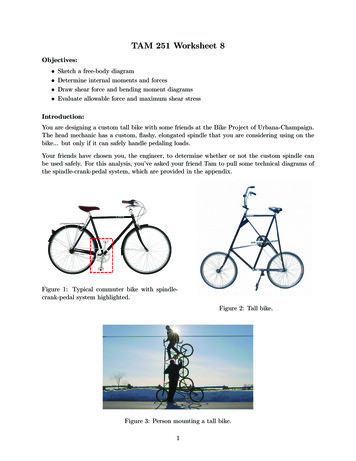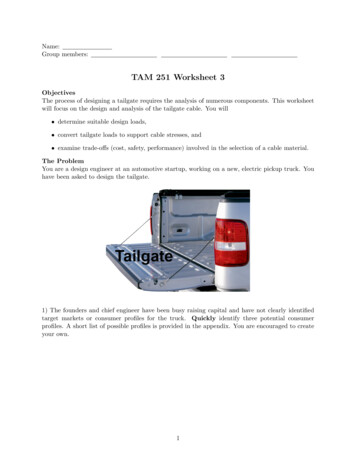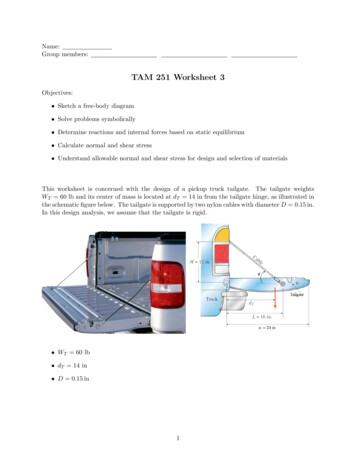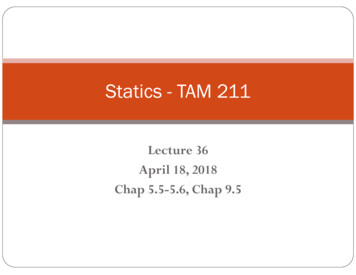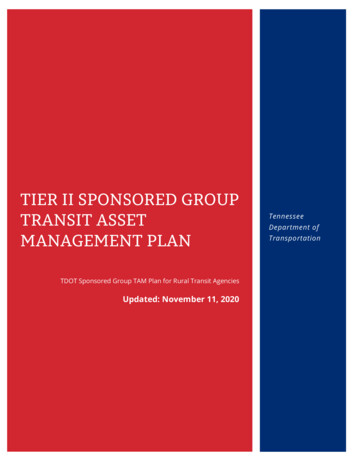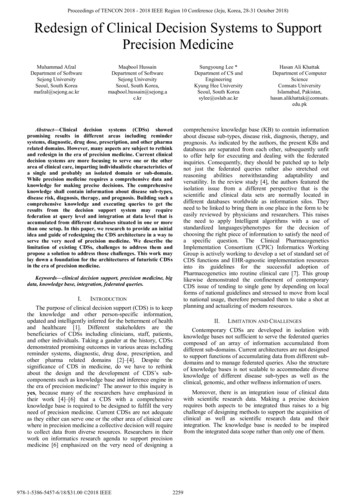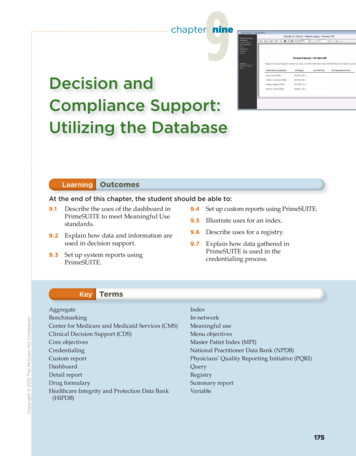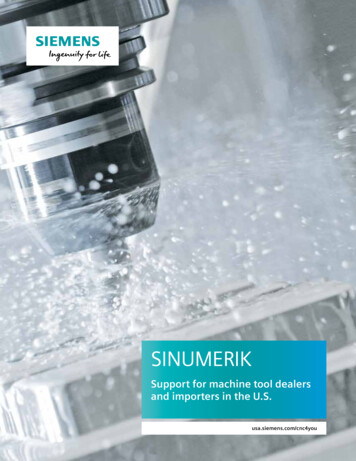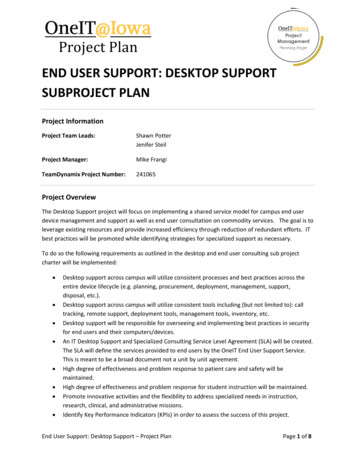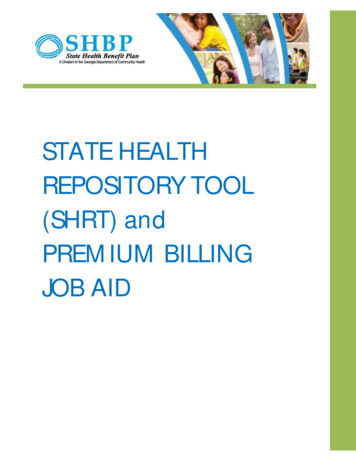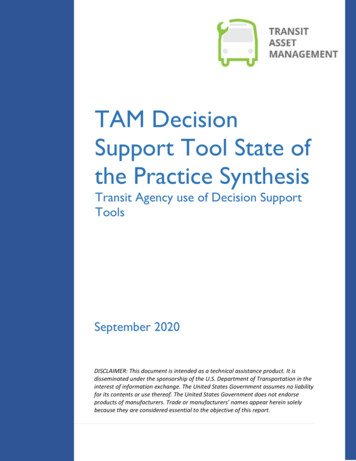
Transcription
TRANSITASSETMANAGIEMENTTAM DecisionSupport Tool State ofthe Practice SynthesisTransit Agency use of Decision SupportToolsSeptember 2020DISCLAIMER: This document is intended as a technical assistance product. It isdisseminated under the sponsorship of the U.S. Department of Transportation in theinterest of information exchange. The United States Government assumes no liabilityfor its contents or use thereof. The United States Government does not endorseproducts of manufacturers. Trade or manufacturers’ names appear herein solelybecause they are considered essential to the objective of this report.1 Page
REPORT DOCUMENTATION PAGEForm ApprovedOMB No. 0704-0188IPublic reporting burden for this collection of information is estimated to average 1 hour per response, including the time for reviewing instructions, searching existing data sources,gathering and maintaining the data needed, and completing and reviewing the collection of information. Send comments regarding this burden estimate or any other aspect of thiscollection of information, including suggestions for reducing this burden, to Washington Headquarters Services, Directorate for Information Operations and Reports, 1215 JeffersonDavis Highway, Suite 1204, Arlington, VA 22202-4302, and to the Office of Management and Budget, Paperwork Reduction Project (0704-0188), Washington, DC 20503.1. AGENCY USE ONLY (Leave blank)I4. TITLE AND SUBTITLE2. REPORT DATEI3. REPORT TYPE AND DATES COVEREDTAM Decision Support Tool State of the Practice Synthesis: Transit Agency Use of Decision SupportTools6. AUTHOR(S)5a. FUNDING NUMBERS5b. CONTRACT NUMBERNoah Augustine, Benjamin Bressette8. PERFORMING ORGANIZATIONREPORT NUMBER7. PERFORMING ORGANIZATION NAME(S) AND ADDRESS(ES)John A. Volpe National Transportation Systems Center55 Broadway, Cambridge Massachusetts 02142DOT-VNTSC-FTA-20-049. SPONSORING/MONITORING AGENCY NAME(S) AND ADDRESS(ES)Federal Transit Administration Transit Asset Management ProgramOffice10. SPONSORING/MONITORINGAGENCY REPORT NUMBER11. SUPPLEMENTARY NOTES12a. DISTRIBUTION/AVAILABILITY STATEMENT12b. DISTRIBUTION CODE13. ABSTRACT (Maximum 200 words)Decision Support Tools must be used to develop a prioritized asset list according to FTA’s Final Rule on Transit Asset Management. These tools can vary in formand scale, to meet agency needs. This synthesis reviews existing documentation on the use of Decision Support Tools, both from publicly available sources, fromthe TAM plans submitted to FTA by agencies, and through interviews with five agencies. The synthesis describes the types of tools used, how they are used, andcommon challenges across the field.14. SUBJECT TERMSDecision Support Tool, Transit Asset Management, COTS, EAM, Planning process, software, transit15. NUMBER OF PAGES2816. PRICE CODE17. SECURITY CLASSIFICATIONOF REPORTNSN 7540-01-280-55002 Page18. SECURITY CLASSIFICATIONOF THIS PAGE19. SECURITY CLASSIFICATIONOF ABSTRACT20. LIMITATION OF ABSTRACTStandard Form 298 (Rev. 2-89)Prescribed by ANSI Std. 239-18298-102
ContentsList of Figures . 4Abbreviations . 5123456Introduction . 61.1Methodology. 61.2Report Organization. 7Types of Decision Support Tools. 82.1Software Packages . 82.2Processes as Tools. 9Literature Review Synthesis. 103.1DST Procurement . 103.2Implementation of Publicly Available Tools. 103.3Literature on Agency Specific Practices . 11State of the Practice for Decision Support Tool Use. 154.1TAM Plan Reporting of Tool Usage . 154.2Incorporating Risk Assessment . 23Implementation Considerations & Opportunities for Future Development . 255.1Change Management, TAM Maturity, and the Use of Decision Support Tools. 255.2Gaps, Needs, and Barriers/Opportunities. 25Conclusion. 276.1Findings . 276.2Considerations for Future Research . 28Appendix A . 29Agency TAM Plans Reviewed . 29Appendix B . 30Agencies Interviewed. 30Appendix C . 31Documents Reviewed . 313 Page
List of FiguresFigure 1: Metrolink table describing asset management software packages, data types, and data details.(Source: Metrolink) . 12Figure 2: Demonstration of structure of two agencies and their DSTs. . 164 Page
PTERM-LiteTIPULB5 PageTermAmerican Public Transportation AssociationCommercial Off the ShelfEnterprise Asset ManagementFederal Transit AdministrationMetropolitan Planning OrganizationState of Good RepairTransit Asset ManagementTransit Asset Prioritization ToolTransit Cooperative Research ProgramTransit Economic Requirements Model LiteTransit Improvement ProgramUseful Life Benchmark
1 IntroductionThe Federal Transit Administration (FTA) published the Transit Asset Management (TAM) rule in 2016 torequire public transit providers that receive federal transit assistance to incorporate transit assetmanagement into their business practices. The rule formalizes a set of reporting requirements for transitagencies, as well as the requirement for each agency to generate and implement a TAM plan outliningtheir asset management practices and procedures.One key element of the TAM plan is a prioritized list of investments, which outlines a basis forinvestment decision-making throughout the life of the assets in the TAM plan. Generating this listrequires using an asset inventory including asset condition and age, as well as considerations of thefiscal and other constraints an agency faces.All agencies are required to use a decision support tool (DST) to generate this prioritized list ofinvestments, and to identify their DST in their TAM plan. The DSTs identified in TAM plans represent awide array of software packages and processes. Guidance given to agencies from the FTA TAM rulespecifically noted that a decision support tool is “an analytic process or tool that assists in capital assetinvestment prioritization and/or estimates capital needs over time (does not necessarily mean softwarepackages)”. While DSTs take multiple forms, each tool allows an agency to take inputs (such as, assetcondition, age, and mileage) and combine it with agency priorities (i.e., maintenance of service levels,safety, risk, etc.) to decide on how that asset compares in funding priority to other assets.Decision-making and prioritization gains complexity with the number of assets included in theprioritization process. While smaller agencies may not have difficulty prioritizing among a dozen busesand their needs for maintenance and replacement, a multi-modal agency’s complexity may require amuch more sophisticated decision support framework, sometimes including many software package orprocess-based tools. The variety of tools described in TAM plans and in literature across the field yields ahighly varied, highly specialized set of options.1.1 MethodologyThis report pulls from a variety of data sources to identify the current state of the practice for use ofDSTs. The primary source of information used in the report was a group of thirty five TAM plansobtained either through publicly available files or through agency TAM plans submitted to FTA. Theseplans were reviewed for any relevant DST practices. The review of literature also included a scan ofliterature on asset management for material on the use of DSTs, including academic, industry based, andFTA publications. Finally, the research team conducted interviews with five agencies of various sizes andgeographic locations to gain additional qualitative information and insight into agency use of DSTs (seelist of TAM plans, literature, and interviewees in the appendix).Selection of both documents for review and agencies for interviews was partially based on agency tier, acategorization of agencies used to delineate TAM plan reporting requirements. The TAM rule separatesagencies into either Tier I or Tier II groupings, depending on the number of vehicles in revenue serviceduring peak service hours and the presence of rail transit. 1 The report includes thirteen Tier I plans, tenTier II plans, and twelve Group plans.FTA. Am I a Tier I or Tier II Agency?, 026/tierchecklist1704.pdf.16 Page
1.2 Report OrganizationThis report explores the types of decision support tools in use, existing literature on the tools, andseveral TAM plans available publicly and through FTA review. The report provides a synthesis of state ofthe practice for how various agencies implement these tools, and covers the following topics: Section 1 introduces DSTs and the background of this synthesis.Section 2 describes the major types of DSTs used by agenciesSection 3 reviews existing literature on DST practices.Section 4 examines the state of the practice of DSTs throughout the field.Section 5 describes considerations for implementing DSTs, as well as common challenges andopportunities in the development of tools.Section 6 provides general conclusions from the research presented.7 Page
2 Types of Decision Support ToolsDecision support tools are used to structure data, organize decision making, and provide a basis forprioritization of assets. The decisions they support include priority for funding, maintenance and assetreplacement. Agencies identified DSTs in their TAM plans including not only software packages as tools,but also processes to reach a consensus on decisions through staff evaluation, other planning processes,or use of project proposal forms for review. Agencies often use multiple types of tools, and sometimesmultiple tools of the same type. This section briefly describes the types of tools contained in the sourcematerial for this report.2.1 Software PackagesMany agencies use one or more software packages to support their TAM decision-making processes.Software packages can track many types of data on assets spanning across multiple functional areas of abusiness. Some of these types of data relate to: Inventory (e.g., asset description, condition assessments, mileage, etc.). Maintenance (e.g., records of past maintenance, upcoming planned maintenance, etc.). Finance (e.g., spending on an asset, depreciation) Procurement (e.g., estimated cost of replacement, asset lifecycle analysis, tracking procurementprocess steps)Software packages vary significantly in size, scope and complexity. There are also many manufacturersoffering software packages within each of the following categories:2.1.1 Commercial Off The Shelf (COTS) Software PackagesCOTS tools are standard software packages available for purchase from third party vendors. Thesesystems may be transit asset specific or general tools used for asset management. The tools ofteninclude optional modules and/or customized configurations to meet an agency’s business needs (such asa maintenance scheduling module, or a financial analysis module). COTS tools can also be enterpriseasset management tools.2.1.2 Enterprise Asset Management (EAM) ToolsEAM tools are a class of software packages designed to provide tracking and decision supportthroughout the entire lifecycle of an asset. These tools are comprehensive in scope, and operate acrossmultiple agency business functions (procurement, prioritization, operations, maintenance, finance, etc.).EAM tools represent a significant investment by an agency, and larger and more complex agencies aremore likely to use them. They are more likely to be custom built, or highly customized, than other tools.2.1.3 Custom Software PackagesSome agencies develop custom DSTs, tailored to the unique needs of their asset management practicesand/or existing IT infrastructure. For instance, legacy systems often have many types of assets that needto be treated differently, and the organizations themselves often have distinct business needs forsoftware solutions. These tools are often complex, resource intensive to create and maintain, butprovide specialized functionality to the agency. They may or may not be comprehensive enough in scopeto be considered EAMs.8 Page
2.1.4Publicly Available Software PackagesAgencies may also choose to use publicly available tools. These tools may be specific to TAM, or generaldata analysis and tracking tools used for TAM purposes. These tools are often the simplest and leastresource intensive to implement; they offer valuable services but may not scale to meet the needs oflarger complex agencies and are often not customized.Many agencies use spreadsheets to track and/or conduct analysis on their transit assets. Spreadsheetbased tools may be simple or complex, but do not generally provide some of the functionalities of otherDSTs. Spreadsheet-based tools frequently pair with other DSTs.Agencies use relational databases for tracking and analysis of transit asset data, sometimes incombination with other tools. Relational databases may provide a more sophisticated method oftracking/analyzing assets than spreadsheets, with far less investment in personnel training or softwarecustomization than many larger software packages.2.2 Processes as ToolsThe FTA TAM rule specifically noted that an agency’s DST does not need to be a software package,acknowledging the validity of the existing process based decision-making tools many agencies use. Thedescription of processes used as decision-making tools overlaps somewhat with the related FTA reportTAM Investment Prioritization State of the Practice.2.2.1Planning Processes2.2.2Review and Evaluation Processes for Individual Projects/AssetsMany agencies identified required, pre-existing planning processes and documents as DSTs. Theseplanning processes were part of existing activities for the transit agency, MPO, or State DOT (such asSTIP/TIPs, etc). The planning process (and plans) can include transit specific project or assetprioritizations, and create an overarching framework within which an agency will create their prioritizedasset list. Alternatively, the planning processes may overlap with the TAM planning process, and theprioritization of assets. TAM plans reviewed included planning processes like the STIP/TIPs; strategicplans; maintenance, operations and capital planning.DSTs also come in the form of a project evaluation process, often involving a multiple month review ofproject applications or asset replacement forms and a set of stakeholders completing a project rankingprocess according to pre-determined criteria. Some agencies required project application forms toinclude a variety of data on asset condition, age, mileage, and maintenance records when submitted.Agencies assessed this data annually based on their priorities for asset investment and review of expertsacross departments to reach consensus on a prioritized asset list.9 Page
3 Literature Review SynthesisThe research team reviewed existing documentation of DSTs from various sources, including individualagency documents and presentations; research reports (from organizations including American PublicTransportation Association (APTA) and the Transit Cooperative Research Program (TCRP)); FTA’s TAMprogram documents and resources; and interview notes from previous FTA research projects. Thisreport pairs with the TAM Investment Prioritization State of the Practice report, which goes deeper intothe strategies agencies use to prioritize their investments.Documentation of best practices and agency use of DSTs is sparse. Few resources discuss the impacts ofDSTs (such as improved ability to prioritize assets, insights into the state of good repair of assets, etc.),the nuances of their use within agencies, or best practices from the field. However, substantivedocumentation exists on selection and procurement of DST software packages and free tools.3.1 DST ProcurementThe January 2020 APTA report, Procuring Software to Support Transit Asset Management, thoroughlyexplores how agencies select and procure DST software packages. 2 This high-level report covers a rangeof topics transit agencies should consider when choosing DSTs, including: business requirements andpractices; software and systems integration; and procurement and implementation considerations. TheAPTA report focuses primarily on the implementation of Enterprise Asset Management (EAM) tools,which provide services in multiple business functional areas across the organization.Agencies seeking to determine which software packages may be the best suited to their context shouldbegin with an examination of their business needs, structure and existing systems. The APTA reportlinked business functions, FTA TAM rule requirements, and the capabilities of various DST softwarepackages. The report included an exploration of how business practices and TAM DSTs must align, andthe difficulties faced by agencies that seek to implement software packages that do not reflect theirbusiness practices. One of the key lessons from the report included the difficulty of integrating tool
obtained either through publicly available files or through agency TAM plans submitted to FTA. These plans were reviewed for any relevant DST practices. The review of literature also included a scan of literature on asset management for material on the use of DSTs, i

